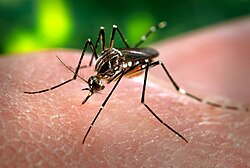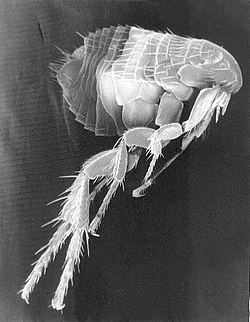World War II

France
France is known to have pursued entomological warfare programs during World War II. [7] Like Germany, the nation suggested that the Colorado potato beetle, aimed at the enemy's food sources, would be an asset during the war. [7] As early as 1939 biological warfare experts in France suggested that the beetle be used against German crops. [8]
Germany
Germany is known to have pursued entomological warfare programs during World War II. [7] The nation pursued the mass-production, and dispersion, of the Colorado potato beetle (Lepinotarsa decemlineata), aimed at the enemy's food sources. [7] The beetle was first found in Germany in 1914, as an invasive species from North America. [9] There are no records that indicate the beetle was ever employed as a weapon by Germany, or any other nation during the war. [9] Regardless, the Germans had developed plans to drop the beetles on English crops. [10]
Germany carried out testing of its Colorado potato beetle weaponization program south of Frankfurt, where they released 54,000 of the beetles. [9] In 1944, an infestation of Colorado potato beetles was reported in Germany. [9] The source of the infestation is unknown, but speculation has offered three alternative theories as to the origin of the infestation. One option is Allied action, an entomological attack, another is that it was the result of the German testing, and another more likely explanation is that it was merely a natural occurrence. [9]
Canada
Among the Allied Powers, Canada led the pioneering effort in vector-borne warfare. [4] After Japan became intent on developing the plague flea as a weapon, Canada and the United States followed suit. [4] Cooperating closely with the United States, Dr. G.B. Reed, chief of Kingston's Queen's University's Defense Research Laboratory, focused his research efforts on mosquito vectors, biting flies, and plague-infected fleas during World War II. [11] Much of this research was shared with or conducted in concert with the United States. [11]
Canada's entire bio-weapons program was ahead of the British and the Americans during the war. [4] The Canadians tended to work in areas their allies ignored; entomological warfare was one of these areas. [4] As the U.S. and British programs evolved, the Canadians worked closely with both nations. The Canadian BW work would continue well after the war, [12] including entomological research. [11]
Japan

Japan used entomological warfare on a large scale during World War II in China. [13] Unit 731, Japan's biological warfare unit, led by Lt. General Shirō Ishii, used plague-infected fleas and flies covered with cholera to infect the population in China. [13] Japanese Yagi bombs developed at Pingfan consisted of two compartments, one with houseflies and another with a bacterial slurry that coated the houseflies prior to release. The Japanese military dispersed them from low-flying airplanes; spraying the fleas from them and dropping the Yagi bombs filled with a mixture of insects and disease. [7] Localized and deadly epidemics resulted and nearly 500,000 Chinese died of disease. [13] [14] An international symposium of historians declared in 2002 that Japanese entomological warfare in China was responsible for the deaths of 440,000. [7] It should also be noted that the U.S. granted Japanese 731 officials immunity from prosecution in exchange for their research, and members of the former 731 Unit went on to have successful careers in business, academia, and medicine. [15]
United Kingdom
A British scientist, J.B.S. Haldane, suggested that Britain and Germany were both vulnerable to entomological attack via the Colorado potato beetle. [8] In 1942 the United States shipped 15,000 Colorado potato beetles to Britain for study as a weapon. [9]


